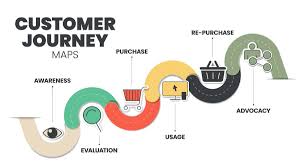Introduction
In today’s competitive digital world, businesses need to understand how customers interact with their brand at every step. This is where customer journey mapping comes in. It helps companies see what their customers experience from the moment they learn about a product to the point they make a purchase—and even beyond.
By clearly understanding the journey, businesses can create better marketing strategies, improve customer experiences, and increase conversions.
This article will explain what customer journey mapping is, why it’s important, and how to create one step-by-step in 2025.
What is Customer Journey Mapping?
A customer journey map is a visual or written representation of every step a customer takes with your brand. It shows how they move through the sales funnel—starting from awareness, to consideration, to purchase, and post-purchase.
It helps marketers answer key questions like:
- Where do customers first hear about us?
- What stops them from buying?
- How can we improve their experience?
Why Is Customer Journey Mapping Important?
1. Improves Customer Experience
Mapping the journey helps find pain points so you can fix them, leading to happier customers.
2. Boosts Conversions
Understanding the journey helps reduce friction and increase purchases or signups.
3. Better Marketing Campaigns
You can send more personalized messages to customers at each stage of their journey.
4. Reduces Customer Churn
When customers have a smooth experience, they’re more likely to stay and buy again.
5. Increases ROI
Smart marketing based on customer insights leads to better return on investment (ROI).
Key Stages of the Customer Journey
- Awareness
The customer learns about your brand for the first time—through ads, blogs, social media, or referrals. - Consideration
They begin comparing your brand with others. They read reviews, visit your site, and ask questions. - Decision
The customer decides to make a purchase or take action. - Purchase
They complete the transaction on your website or through another channel. - Post-Purchase
After buying, the focus shifts to support, feedback, and encouraging repeat purchases. - Loyalty & Advocacy
Happy customers become brand advocates and recommend you to others.
Elements of a Good Customer Journey Map
- Customer Persona: Who is your customer? Include details like age, profession, goals, and challenges.
- Touchpoints: Where does the customer interact with your brand? (e.g., website, email, social media)
- Customer Actions: What steps do they take at each stage?
- Emotions: How do they feel during each step? (e.g., frustrated, excited, confused)
- Pain Points: What problems do they face?
- Solutions: What improvements can you make?
How to Create a Customer Journey Map – Step by Step
Step 1: Define Your Goal
What do you want to understand—product purchase, service signup, or app download?
Step 2: Create Buyer Personas
Identify your ideal customer with basic demographic and behavioral info.
Step 3: List All Customer Touchpoints
From ad clicks to email opens, list where interactions happen.
Step 4: Identify Customer Actions at Each Stage
What does the customer do next? Are they signing up, reading a blog, or leaving the page?
Step 5: Note Customer Emotions and Challenges
Try to understand how the customer feels at every step. Are they confused, excited, or frustrated?
Step 6: Use Tools to Visualize
Use free or paid tools like:
- Lucidchart
- Canva Journey Maps
- Miro
- Figma
- Google Sheets
Step 7: Analyze and Improve
Use your journey map to find weak points and areas where marketing can be improved.
Tools to Help With Customer Journey Mapping
Here are some of the top AI-powered and traditional tools used in 2025:
- Google Analytics 4: For behavior analysis
- Hotjar: For heatmaps and session recordings
- HubSpot: For CRM and journey tracking
- Crazy Egg: Visual behavior tracking
- Funnel.io: For performance across marketing platforms
Real-World Example
Let’s take an online fitness brand as an example:
- Awareness: A user sees a Facebook ad about weight loss tips.
- Consideration: They visit the website, read a blog, and sign up for a free workout plan.
- Decision: They receive an email about a 30-day fitness challenge.
- Purchase: They buy a subscription plan.
- Post-Purchase: They get emails with progress tracking tools.
- Loyalty: They join a community, share results, and invite friends.
This entire journey can be mapped and improved over time using the insights gathered.
Benefits for Businesses in 2025
- More efficient ad spending
- Better lead nurturing
- Improved customer support experience
- Higher engagement on social platforms
- Stronger brand loyalty and customer retention
Final Thoughts
Understanding customer journey mapping is no longer optional in 2025. It is a powerful digital marketing strategy that helps brands improve how they interact with customers at every touchpoint. By mapping the journey, you can uncover customer needs, address pain points, and deliver the right message at the right time.
If you want to stay competitive in digital marketing, investing time and effort into customer journey mapping is a smart move.
